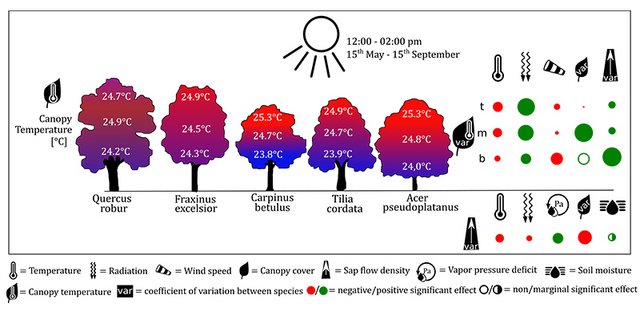As the canopy is the principal site of the exchange of heat, water vapor and atmospheric gases, an essential understanding of plant-atmosphere-interactions is important to enhance global climate models. Facing global warming, findings on species-specific cooling potentials and their main drivers are important in order to mitigate climate change.
For the characterization of species-specific responses to a severe drought in 2018 time series of canopy cover, sap flow density (as a proxy for transpiration) and canopy temperature of Quercus robur, Fraxinus excelsior, Carpinus betulus, Tilia cordata and Acer pseudoplatanus were evaluated. These data as well as micrometeorological parameters were recorded at the Leipzig Canopy Crane research platform.
The effects of species traits and environmental traits on canopy temperature differences in three canopy layers (top, middle, bottom) were assessed through multiple causal pathways within a piecewise structural equation modelling (pSEM) framework. The study revealed that tree species differ significantly in their vertical canopy temperature gradient with radiation, varying canopy cover and sap flow density being the most important drivers. A. pseudoplatanus and T. cordata exhibited the weakest cooling effect, absorbing much radiation with a dense leaf canopy and at the same time reducing stemflow more strongly than Q. robur and F. excelsior during dry periods. It should be noted that even in the lower tree canopy warmer temperatures compared to the ambient temperature occurred more frequently than cooling effects. Consequently, the Leipzig floodplain forest potentially lost some of its capacity to buffer climate extremes when water is limiting.
___
Helen Ballasus conducted the thesis at the institutes of Geography and Biology in the research groups of Prof. C. Zielhofer and Prof. C. Wirth


